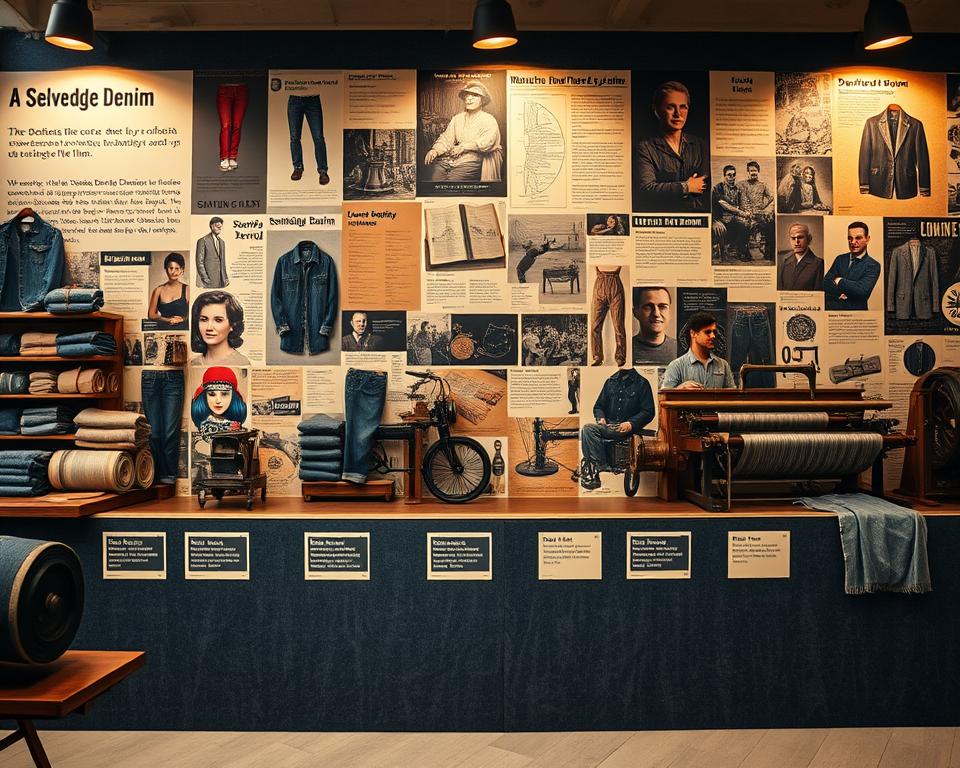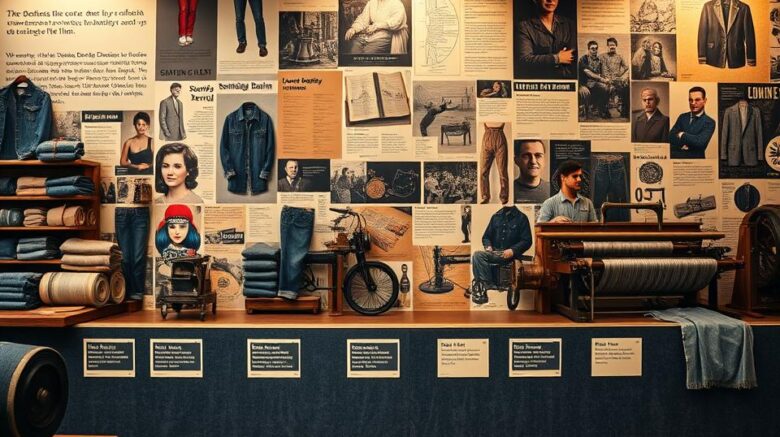Your Guide to High-Quality denim Edge-to-Edge Fabric
Have you ever questioned why some jeans seem as though they are built for endurance eternity? The secret lies in the materials and skill. For example, the growing movement of high-end selvedge. This isn’t just any material—it exemplifies superiority and legacy.
Nowadays, increasingly more individuals are turning to these everlasting fabrics for their durability and classic ewingfly denim charm. Whether you’re a do-it-yourself sewist or a denim enthusiast, there’s an exceptional aspect about working with superior cotton and stitching. It’s not just about making trousers; it’s about producing a legacy.
Within Core Fabrics, we’ve selected a collection of 14.25oz certified organic cotton and stretch choices. These materials are perfect for a spectrum ranging from raw jeans to couture jacket patterns. Prepared to dive into the world of exceptional fabrics? Let us delve in.
Understanding Denim Selvedge Fabric?
What is it that makes particular jeans stand out with their unique, finished without extra steps borders? The secret is found in the selvedge denim, a superior fabric celebrated for its robustness and vintage aesthetic. Unlike conventional textiles, this fabric is fashioned with traditional methods that have stood the test of time.
What Selvedge Denim Means
Selvedge denim is created via old-style shuttle looms, which generate narrow widths of about 30-35 inches. The looms interlace the material in a way that creates self-finished borders, often highlighted by a characteristic red line. Such a process guarantees the textile is densely interlaced and highly durable.
Modern looms, alternatively, produce wider material but lack the same level of skill. Subtle irregularities in selvedge, like twists in the leg or uneven textures, are embraced as part of its charm. This approach, termed “wabi-sabi”, exalts the beauty of inherent flaws.
Production of Selvedge Denim
The production of selvedge denim entails a exacting process. Traditional shuttle looms interlace the horizontal threads back and forth, forming a thick and robust fabric. This process stands in contrast with new-age looms, which prioritize speed and efficiency over durability.
Brands like Karson Denim preserve traditional Japanese weaving techniques from the 90s. They deliberately incorporate flaws to preserve the true character of the fabric. Every item is evaluated on a 4-point system, guaranteeing it fulfills the highest standards of quality.
| Feature | Selvedge Denim | Current Denim |
|---|---|---|
| Width | 30-35 inches | 60+ inches |
| Weaving Process | Traditional Shuttle | Contemporary Loom |
| Finish | Non-uniform, Raw | Consistent |
| Sturdiness | High | Standard |
“The beauty of selvedge resides in its natural irregularities—every imperfection narrates a tale artistry and heritage.”
The History of Selvedge Denim
From humble beginnings to global acclaim, the narrative of these fabrics is multifaceted and motivational. What started as hardwearing clothing in the 17th-century France transformed into a signifier of classic elegance and artistry.
Beginnings in Craftsmanship
The roots of this material dates back to Nîmes, France, where it was known as “serge de Nîmes.” First intended for workers, it was made from robust cotton and yarn. Its resilience made it a favorite among workers during the era of the Gold Rush.
By the 20th century, it had become a staple for pants. The ending of the Cone Mills White Oak factory became a pivotal moment. This shift enabled Japanese craftsmen to reintroduce classic fabric-making practices.

Evolution in Modern Denim Production
Post-WWII, Japan developed a deep appreciation for retro American culture. Skilled workers revitalized old looms to create true reproductions. This devotion to craftsmanship ensured the continuance of selvedge as a niche product.
In modern times, breakthroughs from Italy and Turkey have launched sustainable combinations and flexible variants. These improvements have expanded the appeal of this timeless textile. At Core Fabrics, we gather worldwide, from Montréal to Asia, to bring you the top-notch standards.
“The history of selvedge is a testament to the perennial merit of quality and tradition.”
Why Choose Selvedge Denim?
Why does selvedge denim stand out in the realm of premium fabrics? Its distinct attributes and unmatched durability make it a favorite among enthusiasts and stylists alike. Whether you’re crafting jeans or a structured jacket, this fabric offers a fusion of heritage and updated style.
Unique Qualities of Selvedge Fabric
Selvedge denim is known for its firm interlacing, which enhances ripping resistance and wear patterns. In contrast to common fabrics, rainbow selvedge denim is produced using classic shuttle looms, creating a denser and exceptionally sturdy material. Such a process guarantees that all products boast a unique texture and character.
Notable attributes are:
- Hairy, rigid raw denim contrasts with laundered, relaxed stretch options.
- Sanforization stabilizes the fabric for consistent measurements, while raw options offer a dynamic fitting process.
- Variants include 9.5oz Eco Finish to 14.25oz Organic, suited for varied requirements.
Robustness and Endurance
One of the standout features of selvedge denim is its longevity. The firm interlacing not only increases durability but also allows for unique fading patterns over time. This establishes it as a valuable investment for those looking for timeless pieces.
Key points to consider:
- Fabrics weighing between 12oz and 14oz are perfect for form-fitting jackets and jeans that mellow with time.
- Opt for the 14.25oz True Indigo for traditional jean lifespan.
- Green alternatives, including recycled cotton with indigo blends, contribute to a sustainable collection.
At Core Fabrics, our collection includes a variety of options to suit your needs. From raw to sanforized, each piece is crafted to deliver exceptional quality and value.
Selvedge Denim vs. Wide Denim
For making long-lasting and trendy pieces, the decision of material plays a crucial role. Among the prevalent selections are selvedge and wide denim, both offering different features. Comprehending their variances guides the right one for your creation.
Contrasting Weave Techniques
Selvedge denim is woven on traditional shuttle looms, producing narrow widths of 30-35 inches. This selvedge denim jacket process creates secure finishes, often featuring a characteristic red line. Wide denim, on the other hand, uses modern projectile looms, producing widths of 60 inches or more.
Traditional shuttle looms operate at approximately 3 meters per minute, while projectile looms can produce up to 30 meters per minute. This difference in speed impacts both the cost and the surface quality of the final product.
Advantages and Disadvantages
Selvedge denim is celebrated for its superior quality and strength. Its narrow width renders it perfect for creations where visible hems or patches are desired. However, it can be more expensive, generally priced at $23 per meter.
Wide denim is more cost-effective, priced around $8 per half-meter. Its broader span cuts down on scrap, making it suitable for extensive endeavors like interior décor projects. However, it does not feature the unique edge finish of selvedge.
| Characteristic | Selvedge Denim | Wide Denim |
|---|---|---|
| Measurement | 30-35 inches | 60+ inches |
| Method | Traditional Shuttle | Projectile Loom |
| Output | 3m per minute | 30m per minute |
| Price | $23 per meter | $8/half-meter |
For defined borders as seen in Grainline Thayer jackets, selvedge is favored. Conversely, wide denim is ideal for extensive projects due to its efficiency. Weigh your requirements carefully to decide.
Maximizing Your Selvedge Denim
Working with premium materials can elevate your sewing projects to the next level. Whether you’re crafting trousers, jackets, or frocks, knowing how to measure, sew, and care for the material secures expert outcomes. Let’s explore the optimal use of this classic textile.
Material Requirements for Jeans and Jackets
Determining the proper yardage is key to a successful project. Men’s jeans typically require roughly 3-3.3 yards, factoring in flaws and potential shrinkage. Trucker-style jackets generally demand about 3.3 yards, while skirts require only 2 yards.
Innovative layout techniques can mitigate fabric flaws. Rather than avoiding imperfections, incorporate them into your pattern for distinctive style.
| Project | Fabric Needed |
|---|---|
| Male Jeans | 3-3.3 yards |
| Work Jacket | 3.3 yards |
| Dress | 2 yards |
Advice for Sewing and Longevity
Employing proper equipment and methods leads to an impeccable finish. Select #70 to 110 pins and presser foot attachments made for robust textiles. For contrast stitching, Gütermann rPET thread is a reliable choice.
Here are some additional tips:
- A tailor’s clapper helps deliver defined creases without unwanted shine.
- Our denim kits from Core Fabrics comprise topstitch thread, rivets, and 9mm jeans buttons to ensure a refined result.
- Structured edges, essential for jackets, are best achieved with selvedge.
Correct care ensures your garments last longer. Use minimal washing and opt for air drying to preserve fabric quality. Following these guidelines guarantees enduring results.
Final Thoughts
Crafting with premium materials isn’t just about durability—it’s about creating something with character. Selvedge denim embodies this ideology, merging handcrafted appeal with robust strength. Be it crafting jeans or tailoring a refined jacket, each stitch narrates a tale.
Core Fabrics simplifies your creative journey. Try our swatch service to feel the texture and weight before committing. Additionally, benefit from complimentary shipping on orders exceeding $150 USD throughout North America.
Eco-friendly mixtures and classic washes are paving the way for the next generation of cotton fabrics. Such innovations provide novel methods for infusing eco-consciousness and fashion into your closet.
Ready to dive into the world of premium materials? Begin your journey now and appreciate the merit of intentional crafting. Your subsequent creation may well become an enduring classic.
